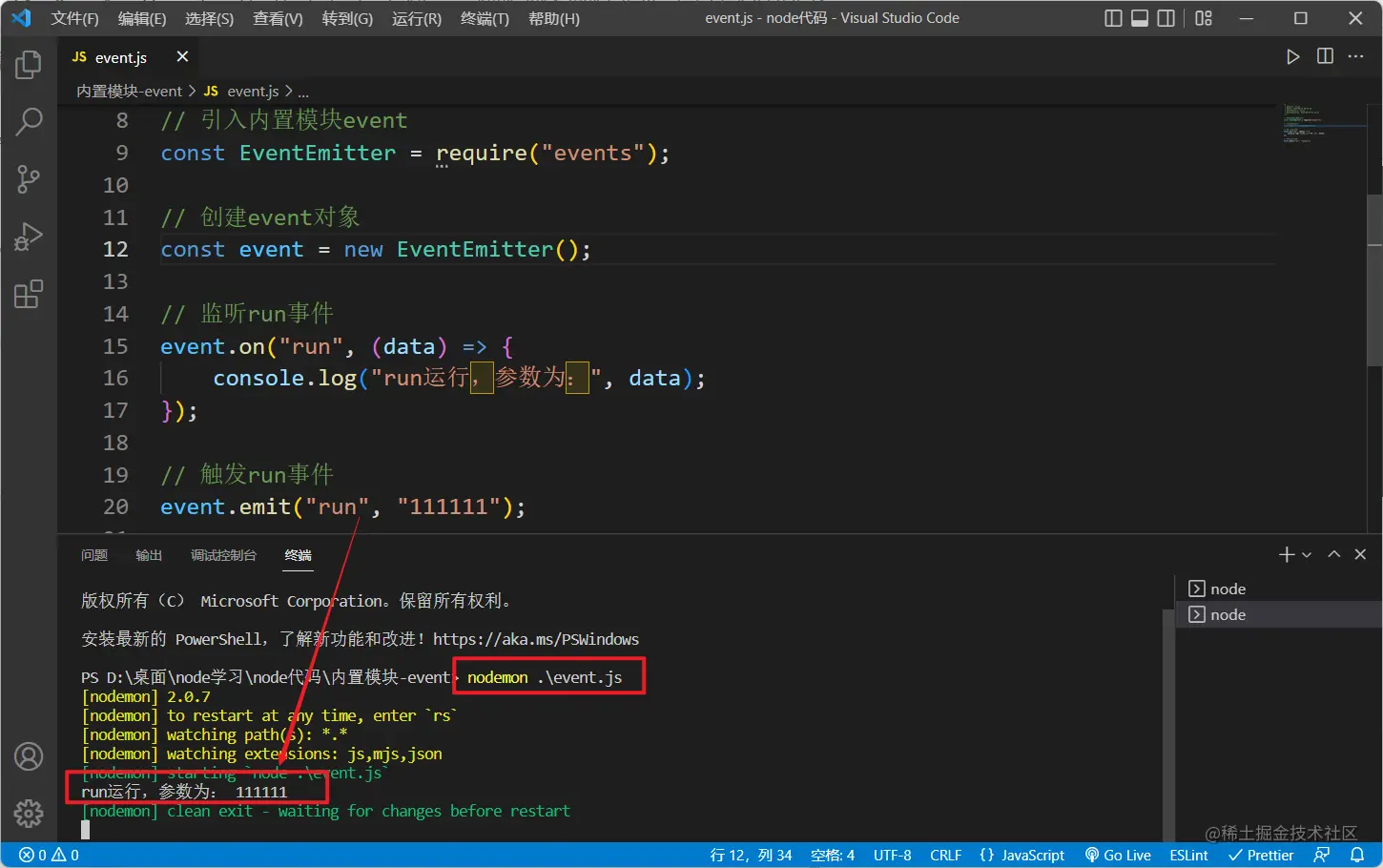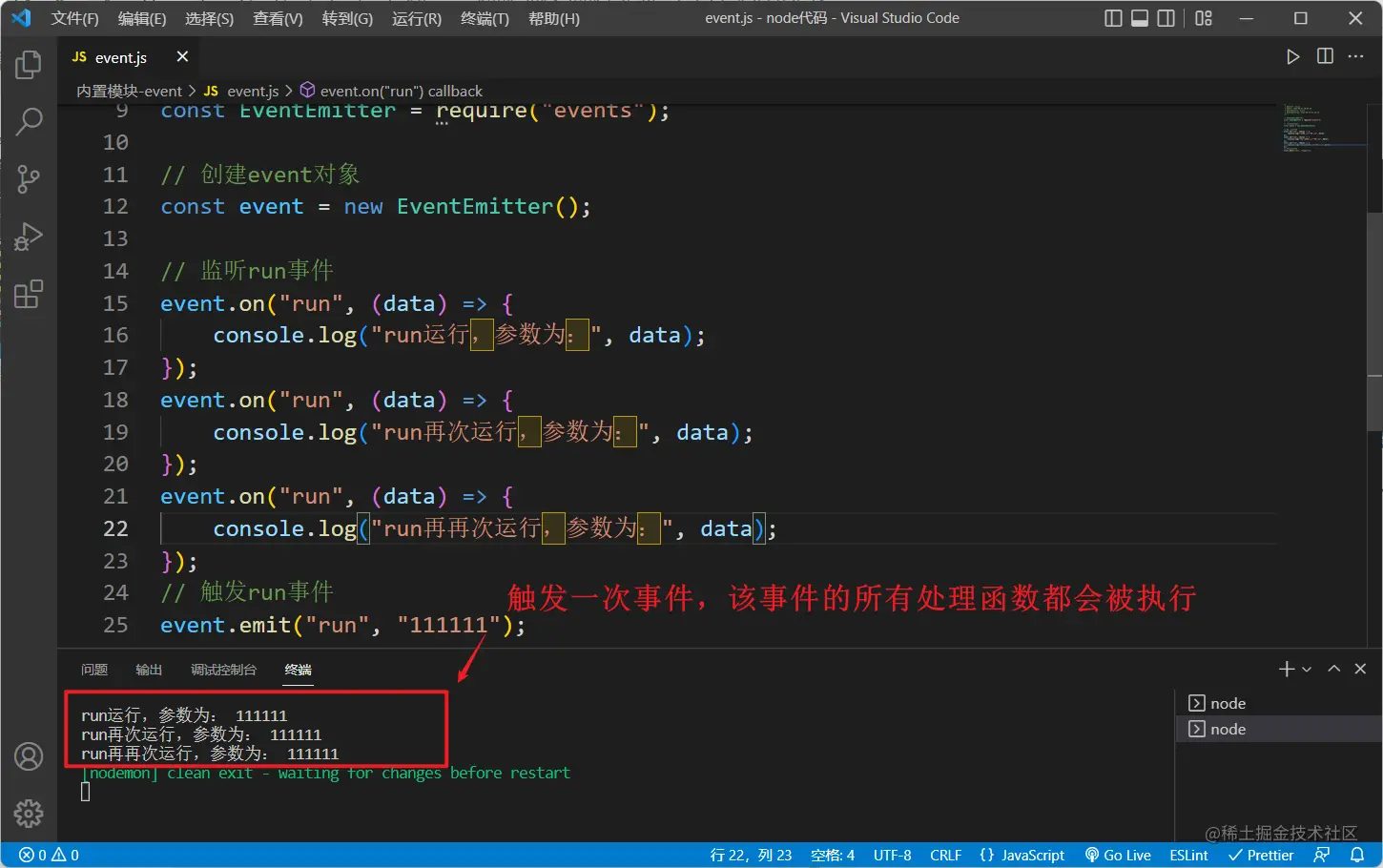 Web Front-end
Web Front-end
 JS Tutorial
JS Tutorial
 The built-in module event of Node.js, how to use it to implement the publish and subscribe model
The built-in module event of Node.js, how to use it to implement the publish and subscribe model
The built-in module event of Node.js, how to use it to implement the publish and subscribe model
Everyone must be familiar with the publish-subscribe model. It plays a great role in asynchronous interaction and can make our code structure clearer, easier to read, and easier to maintain.

In node we can use built-in moduleevent To implement the publish-subscribe model, in this article we will learn in depth event and demonstrate its role in our actual development, let's get started! [Related tutorial recommendations: nodejs video tutorial]
1. Initial use
Introducing the event built-in module
// 引入内置模块event
const EventEmitter = require("events");Create event object
##event
The built-in module is essentially a constructor, we You need to call it through thenewoperator// 创建event对象 const event = new EventEmitter();Copy after login
Listen for events
UseeventThe on function on the object defines a listening event. The syntax is: event.on(event name, event processing function)
// 监听run事件
event.on("run", (data) => {
console.log("run事件运行,参数为:", data);
});Trigger events
Use the emit function on theevent object to trigger the monitored event. The syntax is: event.emit (name of the event that needs to be triggered) , parameters that need to be passed to the event processing function)
// 触发run事件
event.emit("run", "111111");Complete code
// 引入内置模块event
const EventEmitter = require("events");
// 创建event对象
const event = new EventEmitter();
// 监听run事件
event.on("run", (data) => {
console.log("run运行,参数为:", data);
});
// 触发run事件
event.emit("run", "111111");Running result:

❗️ Problem with repeated event monitoring
==Note: When the same event is monitored multiple times When an event is triggered, all event processing functions of this event will be triggered at the same time==
2. Apply
in the previous step SectionNode.js | Build a back-end server (including the use of built-in module http | url | querystring) There is one that uses node to simulate get requests (forwarding across Domain data) case:
const http = require("http");
const https = require("https");
// http和https的区别仅在于一个是http协议一个是https协议
const url = require("url");
const server = http.createServer();
server.on("request", (req, res) => {
const urlObj = url.parse(req.url, true);
res.writeHead(200, {
"content-type": "application/json;charset=utf-8",
"Access-Control-Allow-Origin": "http://127.0.0.1:5500",
});
switch (urlObj.pathname) {
case "/api/maoyan":
// 我们定义的httpget方法:使node充当客户端去猫眼的接口获取数据
httpget((data) => res.end(data)); // 注意这里
break;
default:
res.end("404");
break;
}
});
server.listen(3000, () => {
console.log("服务器启动啦!");
});
function httpget(cb) {
// 定义一个存放数据的变量
let data = "";
// 因为猫眼的接口是https协议的,所以我们需要引入https
// http和https都具有一个get方法能够发起get请求,区别是一个是http协议,一个是https协议
// http get方法第一个参数为接口地址,第二个参数为回调函数
https.get(
"https://i.maoyan.com/api/mmdb/movie/v3/list/hot.json?ct=%E8%A5%BF%E5%8D%8E&ci=936&channelId=4",
(res) => {
// http get方法获取的数据是一点点返回的,并不是直接返回全部
// 监听data,当有数据返回时就会被调用
res.on("data", (chunk) => {
// 收集数据
data += chunk;
});
// 监听end,数据返回完毕后调用
res.on("end", () => {
cb(data); // 注意这里
});
}
);
}httpget((data) => res.end(data)); // 注意这里
cb(data); // 注意这里
httpget function Enter a callback function to receive the data obtained by the httpget function. This writing method is actually no problem and is often used in development.
multi-layer nested function calls (such as the example below), this writing method is not elegant enough because its code structure is not very clear. , cannot understand its logic very intuitively:
function user() {
getUser((data) => {
console.log(data);
});
}
function getUser(cb) {
// ....
const id = 1;
getUserInfo(cb, id);
}
function getUserInfo(cb, id) {
// ....
const name = id + "Ailjx";
cb(name);
}event to transform the above nodesimulationget request ( Case of forwarding cross-domain data):
const http = require("http");
const https = require("https");
const url = require("url");
const EventEmitter = require("events");
const server = http.createServer();
// 存放event对象
let event = "";
server.on("request", (req, res) => {
const urlObj = url.parse(req.url, true);
res.writeHead(200, {
"content-type": "application/json;charset=utf-8",
"Access-Control-Allow-Origin": "http://127.0.0.1:5500",
});
switch (urlObj.pathname) {
case "/api/maoyan":
event = new EventEmitter(); // 注意该位置
// 监听事件
event.on("resEnd", (data) => {
res.end(data);
});
httpget();
break;
default:
res.end("404");
break;
}
});
server.listen(3000, () => {
console.log("服务器启动啦!");
});
function httpget() {
let data = "";
https.get(
"https://i.maoyan.com/api/mmdb/movie/v3/list/hot.json?ct=%E8%A5%BF%E5%8D%8E&ci=936&channelId=4",
(res) => {
res.on("data", (chunk) => {
data += chunk;
});
res.on("end", () => {
// 触发事件并传递数据
event.emit("resEnd", data);
});
}
);
}/api/maoyan interface:

Interface is normal Use
. Pay attention to the position of the above code new EventEmitter(). If new EventEmitter() is external, it is equivalent to There is only one global event object. Every time we call the /api/maoyan interface, node will listen to a new resEnd event, this will cause the resEnd event to be repeatedly listened to:

eventThe code of the objectnew EventEmitter() is written to the case branch of the interface, so that when we call this interface, a new event object will be created , old event objects that are deprecated will be processed by the JS garbage processing mechanism, so that there will be no problem of resEnd events being monitored repeatedly
nodejs tutorial!
The above is the detailed content of The built-in module event of Node.js, how to use it to implement the publish and subscribe model. For more information, please follow other related articles on the PHP Chinese website!

Hot AI Tools

Undresser.AI Undress
AI-powered app for creating realistic nude photos

AI Clothes Remover
Online AI tool for removing clothes from photos.

Undress AI Tool
Undress images for free

Clothoff.io
AI clothes remover

Video Face Swap
Swap faces in any video effortlessly with our completely free AI face swap tool!

Hot Article

Hot Tools

Notepad++7.3.1
Easy-to-use and free code editor

SublimeText3 Chinese version
Chinese version, very easy to use

Zend Studio 13.0.1
Powerful PHP integrated development environment

Dreamweaver CS6
Visual web development tools

SublimeText3 Mac version
God-level code editing software (SublimeText3)

Hot Topics
 Detailed graphic explanation of the memory and GC of the Node V8 engine
Mar 29, 2023 pm 06:02 PM
Detailed graphic explanation of the memory and GC of the Node V8 engine
Mar 29, 2023 pm 06:02 PM
This article will give you an in-depth understanding of the memory and garbage collector (GC) of the NodeJS V8 engine. I hope it will be helpful to you!
 An article about memory control in Node
Apr 26, 2023 pm 05:37 PM
An article about memory control in Node
Apr 26, 2023 pm 05:37 PM
The Node service built based on non-blocking and event-driven has the advantage of low memory consumption and is very suitable for handling massive network requests. Under the premise of massive requests, issues related to "memory control" need to be considered. 1. V8’s garbage collection mechanism and memory limitations Js is controlled by the garbage collection machine
 How to use express to handle file upload in node project
Mar 28, 2023 pm 07:28 PM
How to use express to handle file upload in node project
Mar 28, 2023 pm 07:28 PM
How to handle file upload? The following article will introduce to you how to use express to handle file uploads in the node project. I hope it will be helpful to you!
 Let's talk in depth about the File module in Node
Apr 24, 2023 pm 05:49 PM
Let's talk in depth about the File module in Node
Apr 24, 2023 pm 05:49 PM
The file module is an encapsulation of underlying file operations, such as file reading/writing/opening/closing/delete adding, etc. The biggest feature of the file module is that all methods provide two versions of **synchronous** and **asynchronous**, with Methods with the sync suffix are all synchronization methods, and those without are all heterogeneous methods.
 An in-depth analysis of Node's process management tool 'pm2”
Apr 03, 2023 pm 06:02 PM
An in-depth analysis of Node's process management tool 'pm2”
Apr 03, 2023 pm 06:02 PM
This article will share with you Node's process management tool "pm2", and talk about why pm2 is needed, how to install and use pm2, I hope it will be helpful to everyone!
 Pi Node Teaching: What is a Pi Node? How to install and set up Pi Node?
Mar 05, 2025 pm 05:57 PM
Pi Node Teaching: What is a Pi Node? How to install and set up Pi Node?
Mar 05, 2025 pm 05:57 PM
Detailed explanation and installation guide for PiNetwork nodes This article will introduce the PiNetwork ecosystem in detail - Pi nodes, a key role in the PiNetwork ecosystem, and provide complete steps for installation and configuration. After the launch of the PiNetwork blockchain test network, Pi nodes have become an important part of many pioneers actively participating in the testing, preparing for the upcoming main network release. If you don’t know PiNetwork yet, please refer to what is Picoin? What is the price for listing? Pi usage, mining and security analysis. What is PiNetwork? The PiNetwork project started in 2019 and owns its exclusive cryptocurrency Pi Coin. The project aims to create a one that everyone can participate
 Let's talk about the event loop in Node
Apr 11, 2023 pm 07:08 PM
Let's talk about the event loop in Node
Apr 11, 2023 pm 07:08 PM
The event loop is a fundamental part of Node.js and enables asynchronous programming by ensuring that the main thread is not blocked. Understanding the event loop is crucial to building efficient applications. The following article will give you an in-depth understanding of the event loop in Node. I hope it will be helpful to you!
 Learn more about Buffers in Node
Apr 25, 2023 pm 07:49 PM
Learn more about Buffers in Node
Apr 25, 2023 pm 07:49 PM
At the beginning, JS only ran on the browser side. It was easy to process Unicode-encoded strings, but it was difficult to process binary and non-Unicode-encoded strings. And binary is the lowest level data format of the computer, video/audio/program/network package





